The labor market, a dynamic ecosystem where supply and demand for labor meet, plays a crucial role in every economy. As industries evolve, technological advancements such as artificial intelligence (AI) increasingly shape the future of the labor market. AI is not only altering the way businesses operate but also transforming recruitment, job search, skills development, and workforce management. Understanding these shifts is essential for navigating the new labor landscape.
In this article, we’ll explore the concept of the labor market, discuss the five critical factors that influence it, and delve into the role AI plays in shaping its future. Through this comprehensive guide, we’ll also provide insights into the current state of the U.S. labor market and highlight key trends driven by AI. Whether you’re a business leader, HR professional, or job seeker, this guide will help you stay informed about the future of work in an AI-driven world.
What is the Labor Market?
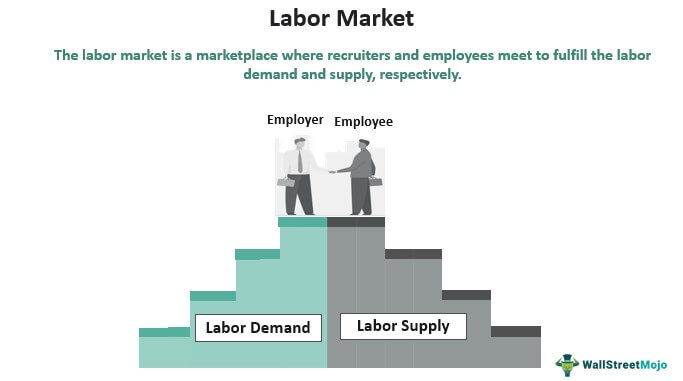
Image Source: WallStreetMojo
The labor market refers to the interaction between workers (labor supply) and employers (labor demand). Workers offer their skills, expertise, and labor in exchange for wages or salaries, while employers seek individuals who meet their needs to fulfill specific tasks or roles within an organization. Simply put, the labor market is the mechanism through which employment is negotiated and established.
The labor market functions within the broader economic context, which means it is influenced by factors such as technological advancements, government policies, and global economic trends. It includes multiple elements such as wage levels, unemployment rates, job availability, and workforce skills.
What’s Driving the Transformation of the Labor Market?
Several variables contribute to the fluctuations and performance of the labor market. Here are the five critical factors:
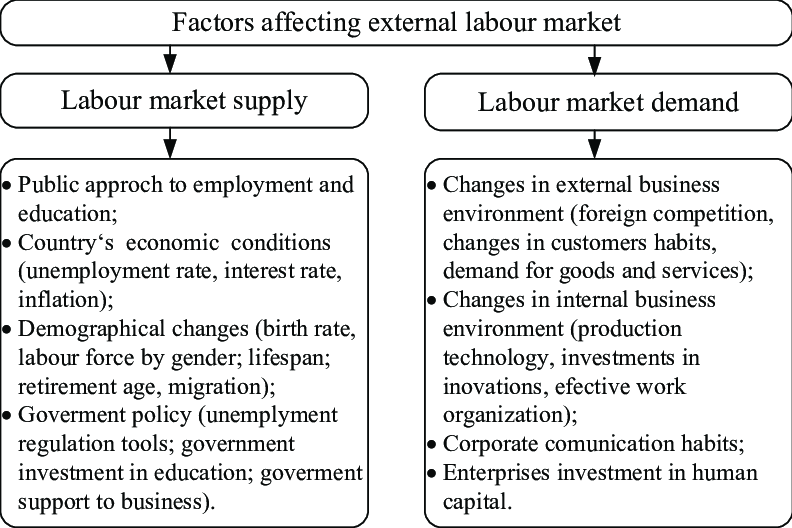
Image Source: ResearchGate
- Supply and Demand: The number of workers available (supply) and the number of jobs available (demand) shape the labor market. A balance between these two determines wage levels and employment rates.
- Education and Skill Levels: Workers with higher education and specialized skills are often more competitive in the labor market, affecting both their employability and earning potential. Conversely, skills shortages in specific sectors can drive up wages and increase demand for workers in those fields.
- Technological Advancements: Innovation, particularly AI and automation, has transformed industries, often reducing the need for routine manual tasks while increasing demand for skilled labor in tech and AI-related fields.
- Government Policies: Labor laws, minimum wage regulations, immigration policies, and social security frameworks play a pivotal role in shaping labor markets by defining working conditions and workers’ rights.
- Economic Conditions: Inflation, recession, or economic growth directly impact hiring trends. In times of economic uncertainty, businesses may hold back on hiring, leading to higher unemployment, whereas strong economic conditions tend to create more job opportunities.
US Labor Market Today: Key Insights and Trends
The U.S. labor market is one of the largest and most diverse in the world. It has seen significant transformations in recent years, driven by technological advancements, globalization, and demographic shifts. While the U.S. labor market recovered from the disruptions of the COVID-19 pandemic, new challenges like inflationary pressures and labor shortages have emerged.
As of 2024, the U.S. labor market is characterized by:
- A high demand for technology and healthcare professionals.
- Persistent labor shortages in sectors like hospitality and retail.
- The rise of the gig economy and remote work arrangements.
- An increasing need for reskilling and upskilling the workforce in response to rapid automation and AI integration.
How AI is Shaping the Future of the Labor Market?
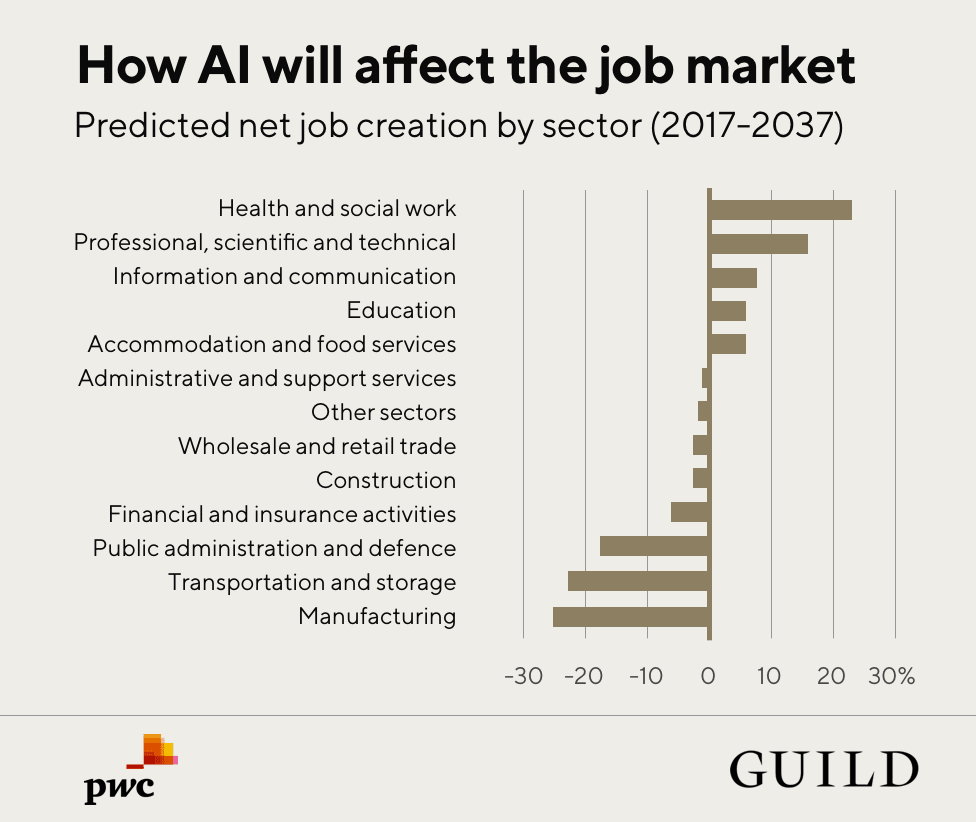
Image Source: Guild
Artificial Intelligence (AI) has become a powerful force driving changes in the labor market. AI technologies are being used in multiple facets, from recruitment processes to labor market analysis, and are reshaping the structure of work. AI’s role in the labor market can be divided into three main areas:
- Automation of Tasks: AI is automating repetitive and low-skilled tasks, reducing the need for human workers in certain industries but simultaneously creating new jobs that require advanced technological skills.
- Improved Labor Market Efficiency: AI tools can streamline hiring, training, and workforce management processes, making it easier for businesses to find qualified candidates and for job seekers to find suitable positions.
- Enhanced Data Analysis: AI algorithms can analyze large datasets quickly and effectively, providing real-time insights into labor market trends, wage levels, and employment patterns. These insights help businesses, policymakers, and economists make informed decisions.
What Happens in the Labor Market with AI Integration?
When AI is integrated into the labor market, several changes occur. AI-driven recruitment platforms improve how companies attract and assess talent, using algorithms to screen candidates and match them to jobs more accurately than ever before. At the same time, AI systems enhance employee training and development through personalized learning plans based on individual performance data.
For workers, AI creates both opportunities and challenges. While AI can reduce employment in certain sectors by automating routine tasks, it also generates demand for skilled workers in AI development, machine learning, and data analysis. Workers need to continually update their skills to stay competitive, and businesses must rethink their workforce strategies to keep up with the evolving demands.
How AI is Changing Recruitment and Job Search?
AI is revolutionizing the recruitment landscape in several key ways:
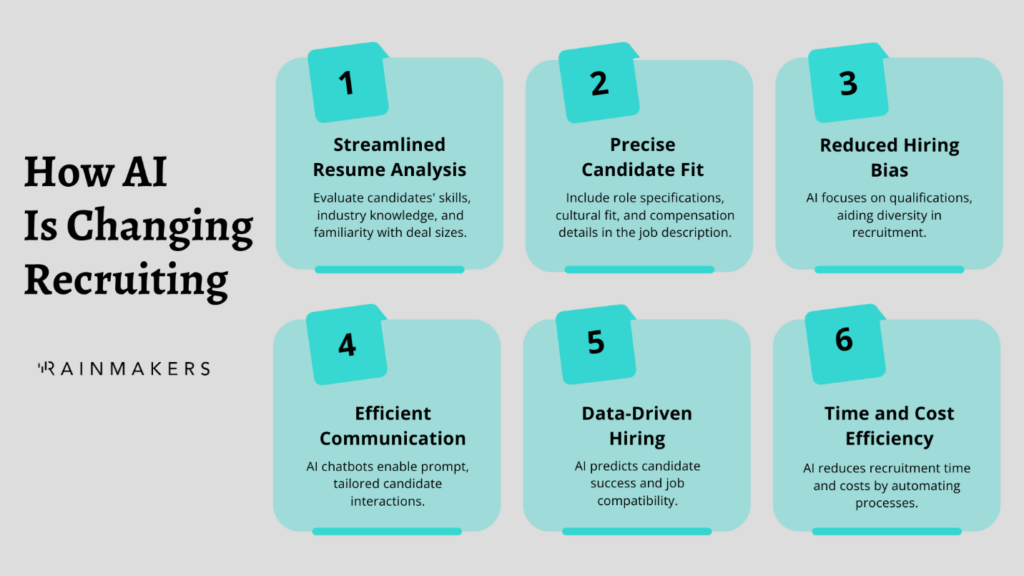
Image Source: Rainmakers
- Candidate Screening: AI-driven applicant tracking systems (ATS) use algorithms to sift through resumes, highlighting candidates who match the required qualifications. This speeds up the hiring process and reduces human error in shortlisting candidates.
- Predictive Analytics: AI-powered recruitment platforms use predictive analytics to assess a candidate’s likelihood of success in a particular role based on their past experience, performance, and skills. This enables more accurate and objective decision-making.
- Job Matching: AI uses data from both job seekers and employers to match candidates to positions that best suit their skills, experience, and preferences, improving the likelihood of long-term employment satisfaction.
- Chatbots for Recruitment: AI chatbots help streamline the hiring process by interacting with candidates, answering their questions, scheduling interviews, and providing status updates.
- Bias Reduction: AI systems can help reduce biases in the recruitment process by focusing on data-driven attributes rather than subjective judgments, although there are ongoing concerns about AI bias if not properly managed.
AI Impact on Labor Market Data Collection & Analytical Strategies
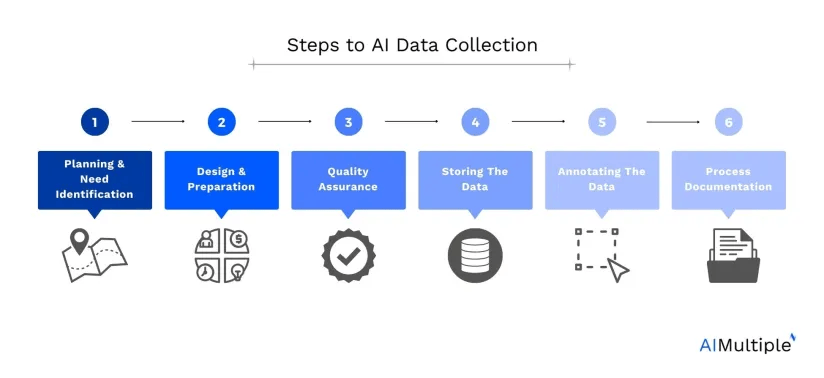
Image Source: AIMultiple
AI is revolutionizing how labor market data is collected and analyzed. With vast amounts of data generated by job postings, economic indicators, and worker profiles, AI-powered platforms can process this data to identify key labor market trends, forecast job growth, and provide real-time labor market insights.
The Role of AI in Labor Market Analysis
AI-based analytics provide a more accurate and timely understanding of the labor market by processing vast amounts of structured and unstructured data. This includes job postings, employment statistics, salary data, and more, which can help policymakers and businesses make data-driven decisions.
AI-Driven Labor Market Trends
AI has given rise to several key labor market trends, including:
- Automation of Routine Tasks: Automation is reducing the need for manual labor in sectors like manufacturing and logistics while driving demand for highly skilled roles that focus on managing, developing, and implementing AI technologies.
- Enhanced Job Matching: AI algorithms make it easier to match job seekers with the right positions, improving overall employment rates and reducing turnover by placing candidates in jobs suited to their skills and preferences.
- Skills-Based Hiring: AI-driven hiring platforms focus more on skills rather than traditional qualifications such as degrees, which helps businesses find talent based on practical abilities. This trend is helping to democratize the hiring process and increase access to employment.
- Increased Demand for Tech and AI Skills: As AI becomes more prevalent, there is a growing demand for workers with tech and AI-related skills. Roles such as data scientists, machine learning engineers, and AI specialists are among the fastest-growing jobs.
- Gig Economy Expansion: AI and digital platforms are facilitating the growth of the gig economy by connecting freelancers with short-term job opportunities. These platforms leverage AI to match workers with gigs that align with their skills and availability.
- AI-Enhanced Labor Market Analysis: AI provides deep insights into workforce trends, helping businesses anticipate skills shortages, wage fluctuations, and employment opportunities.
- Remote Work and AI Collaboration Tools: AI-powered collaboration tools are enabling remote work, improving communication, project management, and team collaboration in distributed work environments.
- Diversity and Inclusion Initiatives: AI is being leveraged to enhance diversity and inclusion in hiring by removing unconscious biases and ensuring that underrepresented groups have equal access to job opportunities.
- AI-Driven Personalized Learning and Development: AI tools offer personalized learning pathways for employees, ensuring that they acquire the skills needed to advance their careers in an AI-dominated labor market.
- Reshaping Industries and Job Creation: While AI may displace some jobs, it is also creating new industries and job roles, particularly in AI development, cybersecurity, and data science. Industries like healthcare, finance, and education are experiencing significant transformation due to AI adoption.
Regional Analysis of the Labor Market
AI’s Impact on the US Labor Market
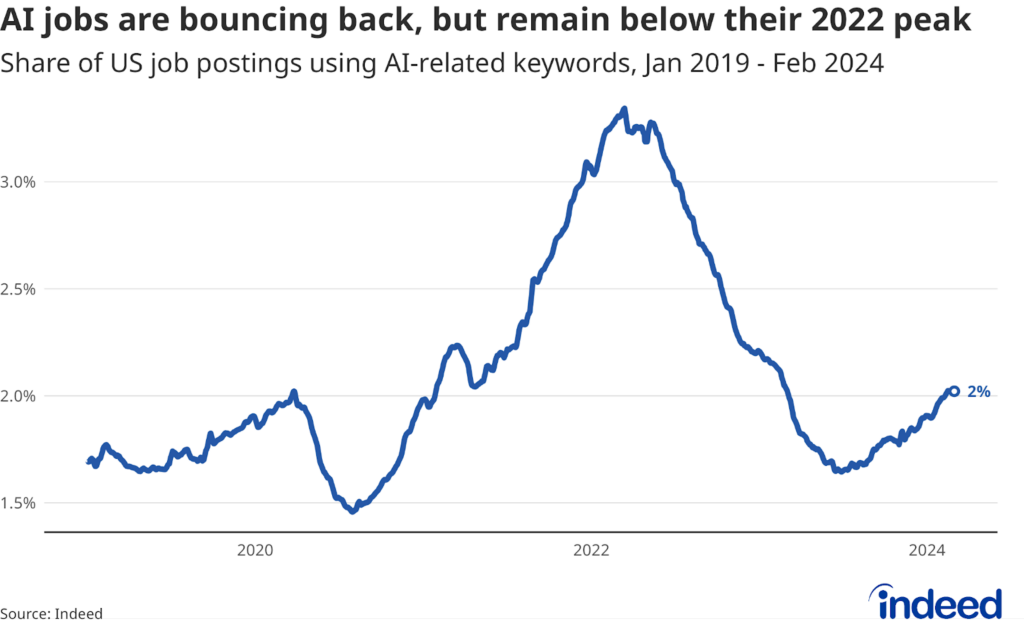
Image Source: Indeed
In the U.S., AI has led to both job displacement and creation. While routine and manual jobs in industries such as manufacturing have seen a decline due to automation, new opportunities in tech, healthcare, and AI-related fields have emerged. The U.S. labor market has also experienced a rise in gig work, remote jobs, and freelance opportunities, supported by AI-driven platforms.
AI in the Global Labor Market (Europe, Asia-Pacific, etc.)
AI’s influence on the labor market is a global phenomenon. In Europe, AI is being used to address labor shortages, particularly in countries with aging populations. Asia-Pacific is experiencing rapid AI adoption in sectors like manufacturing, finance, and telecommunications, reshaping the labor market across the region. Each region faces unique challenges and opportunities as they integrate AI into their workforce strategies.
Challenges and Opportunities
Addressing the Skill Gap: AI’s Role in Bridging the Gap
One of the primary challenges with AI adoption in the labor market is the growing skills gap. AI is creating demand for specialized skills that many workers do not possess. However, AI-driven learning platforms are helping to bridge this gap by offering personalized learning opportunities and training programs that target specific skills required in the evolving labor market.
Ethical Considerations and Bias in Labor AI
As AI becomes more integrated into recruitment and workforce management, ethical concerns are increasingly coming to the forefront. Issues such as bias in AI algorithms, privacy concerns, and the potential for job displacement need to be addressed. Organizations must ensure that AI systems are transparent, fair, and inclusive to avoid exacerbating existing inequalities in the labor market.
Future Opportunities: AI’s Potential to Transform the Labor Market
AI presents a host of future opportunities for transforming the labor market. From improving workforce productivity through automation to enabling more equitable hiring practices, the potential benefits of AI are vast. As industries continue to adapt, there is immense opportunity for workers and businesses to leverage AI to drive innovation, improve efficiency, and create new job opportunities.
Case Studies and Success Stories
Real-World Applications of AI in the Labor Market
AI has already begun transforming industries like healthcare, manufacturing, and finance. Companies such as IBM and Google are using AI to streamline recruitment processes, reduce bias in hiring, and offer personalized training solutions. In healthcare, AI is improving diagnostic accuracy and patient care, while in manufacturing, AI-powered robotics are increasing production efficiency.
How JobsPikr Utilizes AI to Enhance Labor Market Insights
At JobsPikr, we leverage AI to provide businesses and organizations with accurate, real-time labor market data. Our AI-powered platform analyzes millions of job postings, employment trends, and economic data to deliver actionable insights that help companies stay ahead of labor market shifts.
Insights from JobsPikr Data
Our data shows that AI is driving demand for tech skills across all industries, while also reshaping hiring practices with a focus on skills-based recruitment. As industries adapt to AI, we’re seeing an increase in remote work and a growing need for diversity and inclusion in hiring strategies.
Unique Insights Derived from Our Data
JobsPikr’s AI-driven insights reveal that sectors like healthcare, IT, and finance are experiencing the most significant AI-driven transformation. Our data insights also highlights the rising importance of soft skills, such as adaptability and problem-solving, in an AI-driven job market.
Conclusion
AI is transforming the labor market in profound ways, creating new opportunities while also presenting challenges. Understanding the impact of AI on recruitment, job search, skills development, and labor market trends is essential for both businesses and workers. With AI’s continued advancement, the future of the labor market holds exciting possibilities.JobsPikr is here to help you navigate these changes by providing data-driven insights and real-time labor market analysis. To learn more about how AI can help your business thrive in the evolving labor landscape, sign up today.



